Verdict
The Onimusha 2 remaster does exactly what it says on the tin. Sharp visuals breathe new life and color into a cult classic that merits a life beyond the PS2. However, Capcom’s dedication to the original experience means that decades-old problems remain unaddressed, and its capitulation to analog movement undercuts the authenticity it sets out to achieve.
Onimusha? You should. The brainchild of Keiji Inafune, it could be considered the precursor to Devil May Cry, Sekiro, and Nioh. To my mind, it's 'required reading' for anyone whose interests sit at the intersection of PlayStation, Capcom, and character action. However, up until last year, Onimusha was consigned to cult status – once record-breaking, now a footnote in the legacy of games that came after. But before we get to see what a new Onimusha looks like, Capcom has graced us with a surprise aperitif: an Onimusha 2: Samurai's Destiny remaster.
If 2024 was the Oblivion Remastered review, but it bears repeating: remasters are weird. Remakes have a definitive intent; remasters are a far more nebulous endeavor.
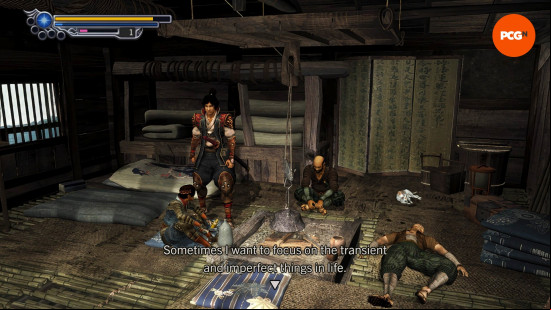
Mercifully, Capcom announces its intentions for the Onimusha 2 remaster in a splash screen sandwiched between the health warning and main menu: "The contents of this game are presented with minimal changes to preserve an authentic experience reflecting the original release." If Capcom wants to save me the trouble of dragging my black-label copy of Onimusha 2 out from the IKEA storage box under my bed, that's fine by me.
Its precursor, Onimusha Warlords, is one of my favorite action-adventure games. Billed as a Sengoku-flavored Resident Evil, its compact plot and economical action make it all too easy to return to year after year. Its sequel, however, is another story. Onimusha 2 is still a Keiji Inafune production, but it is also a very different beast. It casts off the shadow of Resident Evil to establish its own series identity, but in doing so, it separates itself from what came before. While Warlords is an action-survival horror, Samurai's Destiny is a feudal fantasy adventure.
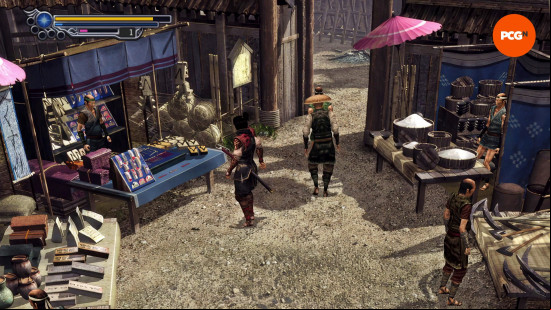
Right off the bat, this remaster brings the textural richness of Onimusha 2's pre-rendered backgrounds into high definition. The caves and forests are as drab as they ever were, but distinctive areas like Jujudormah's bedroom boast an opulence that the PS2 couldn't fully capture. The return to Gifu (née Inabayama) Castle proves that Capcom has taken the same approach to the Samurai's Destiny remaster as Warlords; it looks identical to how it did six years ago.
For the uninitiated, Inabayama Castle is analogous to Resident Evil's Spencer Mansion. While both are clearly defined locations – Inabayama Castle is a real historical castle that you can visit today – their structural layout and dream logic convey an extratemporal quality. Contrast this with Imasho, a gold-rush village teeming with miners, drunkards, and comfort women. Onimusha 2 refrains from leaning fully into the historical bent established by its predecessor, but it certainly embraces it with gusto. It also takes the camp undertones of Warlords and dials them up to 100.
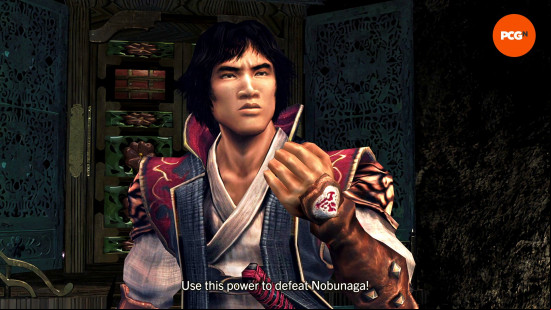
Protagonist Jubei returns home to discover his entire clan has been massacred by demons. "Who did this?!" he growls. His fist clenches. His brow quakes. A lightning strike lights up the sky behind him. Later, he takes a moonlit gallop with love interest Oyu on the back of a mechanical horse. She gazes up at him, starry-eyed, likely struck by his cut-glass jawline and Handsome Squidward-esque pout. However, none of this touches the camp heights of Gogandantess, self-styled as "the greatest swordsman of all the demons." Where the rest of Onimusha 2's bosses are your standard cartoon side-villains, Gogandantess steals the show with nipple armor, a gravity-defiant bob, and an unshakable code of honor that pushes him firmly into anti-villain territory.
Inversely, Warlords is a lonely affair by design. With the exception of Kaede (incidentally crowned by FHM as one of the "sexiest ninja babes" in gaming), Samanosuke is the last hope for Princess Yuki. In Onimusha 2, Jubei has a whole posse at his beck and call. There's no question that I'm meant to care about this ing cast, but their assistance seems more incidental than it does collaborative. Their appearance is dictated by a rudimentary gift system that gives you a little insight into their personalities. Magoichi loves books. Kotaro loves weird trinkets. Ekei loves alcohol and women. It's not enough to get me invested, and the token items they offer in exchange are an overtly transactional interpretation of friendship that shows Onimusha 2's age. The succession of betrayals and revelations in these scenarios is as clumsy yet earnest as the scenario system itself.

With more interactions on the table, Onimusha 2 is more prone to adopt the particular brand of racy yet ultimately harmless innuendo endemic in JRPGs at the turn of the millennium. Often fleeting, it nevertheless constitutes a dramatic tone shift for the series. Warlords is wholly sexless; in Samurai's Destiny, everyone is horny. Oyu is horny for Jubei. Jujudoma is horny for Nobunaga. Ekei is horny for, well, any woman that stands still long enough. Onimusha 2 never oversteps the mark, but it does make for some bizarre beats, such as when Jubei and friends rescue a villager's "cute" daughter, only to discover she's a baby. This makes for a fun lampshade moment, until it sends Ekei into a PTSD flashback of his wife and child burning to death. I could make an insurance claim for this tonal whiplash.
In classic samurai fashion, Jubei is only horny for revenge, and Onimusha 2's combat system certainly delivers. The weapons that Samanosuke wields in Warlords are distinct in form but not in function. They are all ostensibly blades that hit with variable speed, power, and elemental magic. Onimusha 2 builds on these foundational principles just enough for a bit of light strategy. Jubei's hammer is the best way to bring down a hulking brute, but it's too slow to handle acrobatic foes. Conversely, his spear keeps enemies with long reach at bay, while his naginata delivers a relentless barrage of light attacks. All this with a buttery-smooth framerate to better land those parries (ahem – Issen). It's perfectly feasible to approach Samurai's Destiny as a basic hack-and-slash game, but quite frankly, you'd be robbing yourself of the dopamine shot that a successful counterattack delivers.

Like 2019's Warlords, the Onimusha 2 remaster includes the option to forego the traditional tank controls for analog movement. I'm sure this will come as a relief to many, but to my mind, it's a travesty. Yes, when improperly handled, tank controls are unwieldy – but so is a samurai sword. Both demand precise movements and a keen awareness of your surroundings, and while I'm not about to prescribe an identical likeness, analog movement deflates all the tension of Onimusha 2's combat like the air out of a whoopee cushion. How could I possibly feel threatened by a demon mob advancing on all sides when I can just dance my way around them with a twist of my analog stick? Frankly, I can't. The only real difficulty analog movement poses is running in the wrong direction whenever you enter a new screen.
Look, I get it. You can't throw a rock in the Onimusha fanbase without hitting someone trying to remap their emulation controls, and the Warlords remaster's analog movement was largely well-received. However, I maintain that tank controls are as integral to Onimusha as Resident Evil. The convenience of analog is a temptation that hangs over both remasters, and the moment you take that path of least resistance, the "authentic experience" that Capcom so conscientiously pledges to preserve is lost.
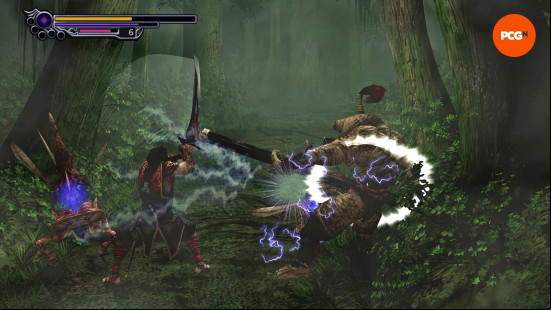
My enduring love for tank controls notwithstanding, I do have a huge bone to pick with Onimusha 2's fixed camera angles. Given its claustrophobic setting, areas in Warlords are siloed off from one another by doors that require player input to progress. Onimusha 2's static screens are open-ended. This makes the world feel somewhat more connected, but can be a source of great frustration if you happen to stumble into the next screen – or, even worse, if enemies push you into the one that came before.
It's not much better in large areas, either. The camera constantly cuts back and forth to capture every corner, often at the expense of sightlines. It works to great effect for horror and suspense in Warlords; in Samurai's Destiny, it's suffocating. I often find myself boxed into the invisible boundaries that mark camera transitions, desperately trying to avoid being blinded to enemy movements. I'm not sure if my showdown against Oda Nobunaga needed seven camera angles, especially when over half of them work against me.
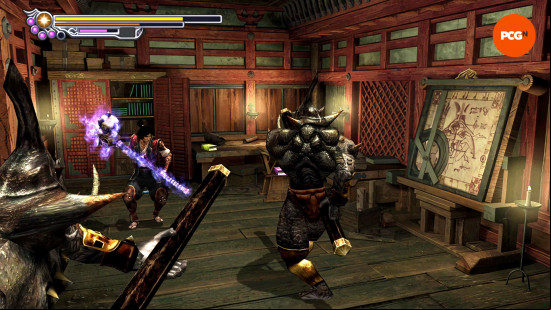
It certainly doesn't help that the spawn rates in Onimusha 2 are unbelievably high. Samurai's Destiny diversifies the Genma army, but the novelty of alligator men, weird rotor bugs, and masked demons with wolverine claws soon wears off when you have to fight waves of them on every screen. I can only surmise that this was for the sake of balance, but given the amount of demon souls it takes to level up your equipment, Capcom could afford to relax both. Doubtless, such an adjustment would compromise that "authentic experience" – perhaps I should just be grateful that I don't have to level up weapons and orbs separately like in Warlords.
The Onimusha 2 remaster might be faithful to a fault, but I have to give special mention to a few small yet substantial additions that Capcom has thrown in for good measure. The inclusion of the Japanese dub finally remedies the stilted English performances and mismatched lip syncing, though it does mean I miss out on Dee Baker's vocal antics as Gogandantess. There's also Hell Mode: a one-hit KO difficulty that I won't be clearing any time soon. Aside from that, though, everything is as it was in 2002. Like Oblivion Remastered, I'm not sure if a remaster of Onimusha 2 was strictly necessary, particularly one that remains so faithful to its original blueprint. Unlike Oblivion Remastered, the availability of Onimusha 2: Samurai's Destiny on PC and modern consoles is a decisive win for game preservation, and the perfect opportunity to capture a new audience before the Onimusha: Way of the Sword release date rolls around.
